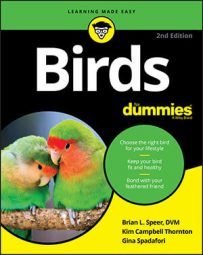The day you bring your bird home is the day the world changes for you both. For you, this is the grand moment when all your research and admiration of birds suddenly becomes quite real.
For your new bird, this momentous day can be downright scary. The breeder's home may have been the only world he has ever known. Even if your bird came from a pet shop and is used to a constant parade of strangers, your home is something new, and so are you. If you purchased a budgie or cockatiel, his interactions with humans have been restricted to being netted out of a group of his buddies to be shipped to a pet store to wait to be netted again when purchased. Can you help these birds become confident pets?
Or maybe you've taken on a real challenge, a bird that has been sold and sold again, passed from owner to owner and perhaps mistreated along the way. This character views the world with cynicism and fear, and he figures you're bound to be another disappointment. Can you really change his outlook?
The trick in all cases is patience, consistency, and knowledge. Getting your bird settled in comfortably and establishing your relationship is a two-part process: You have to ensure that your bird's physical environment is satisfactory, and then start working on his attitude toward you.
Setting up the cage
The cage is your bird's castle, the place where he will spend much (or all, in the case of finches or budgies) of his time. A cage protects your bird and shields your stuff from your bird, who is perfectly capable (if he's a parrot) of reducing prize antiques to toothpicks with his powerful beak.
Choose a location where your bird can be adjacent to family activities, but not in the center of them. Your bird will feel most comfortable if his cage is against a wall, so he can watch the goings-on without having to worry about anyone sneaking up on his backside. For the same reason, place the cage where your bird won't be surprised — for example, away from large furniture that may block his view of the room and the comings and goings of family and friends. Birds don't like to be startled any more than we do!
Position the cage far enough away from a window so the sun doesn't fall on your bird and overheat him. Putting the cage near a window so your bird can see out isn't a bad idea, though. It'll keep your pet entertained.
Although the kitchen may seem like an ideal place for your bird's cage, think again. The potential for your bird to breathe deadly fumes, such as those from burning nonstick cookware is too high to take a chance. Situate your bird's cage someplace else where the people in your home hang out.
Don't get too enthusiastic about toys right away — two or three are fine, but more may be overwhelming. Use a variety of natural and store-bought perches, and position them so they aren't directly over food and water dishes. You don't want to encourage your bird to poop into his dishes.
Line the cage bottom with newspaper or another safe product, and you're ready to introduce your bird to his new home.
Traveling home
Bigger parrots require a couple of accommodations, one for traveling and one to call home. That's not the case with little birds; one properly sized cage is plenty. The temptation to buy a bird, buy a cage, stuff the former into the latter, and race for home may be inviting, but let it pass. Large or small, your bird will be more comfortable in a small box or carrier, with a towel draped over it to darken the space and relax him. (Make sure to leave a couple of air holes.)
Put a towel in the bottom of the box or carrier to provide the bird with secure footing and stop him from sliding around, even if a perch is available.
Place the carrier where it won't move around or fall. You can put it on the passenger-side floorboard or put the seat belt through the handle to secure it in the seat.
Don't put the carrier in the trunk — exhaust fumes can kill your new pet. And don't put your small bird in a small carrying box on the dashboard while you are driving home — that would be a bad experience for both you and the bird.
Settling in
When you get home, put your bird in the cage and let him be. He needs time to adjust to his surroundings. No matter how cute he is, how much you want to show him off, or how much the kids want to have him perch on their fingers, let your bird be.
Give him three days of peace to adjust. You'll have the rest of your lives together, so laying off for a mere 72 hours really isn't asking a lot.
This doesn't mean you can't talk to your bird; in fact, you should communicate with your new family member — gently, and with the utmost respect for how frightened he may be. Sing to him. Read the newspaper to him. Make eye contact and tell him he's beautiful and you love him.
But as for physical contact, hands off for now. You have to change the cage liner, clean and refill food and water receptacles, and add and remove fresh foods, but do so slowly, calmly, and deliberately. Don't be insulted if he chooses to move as far away from you as possible; your day will come.

